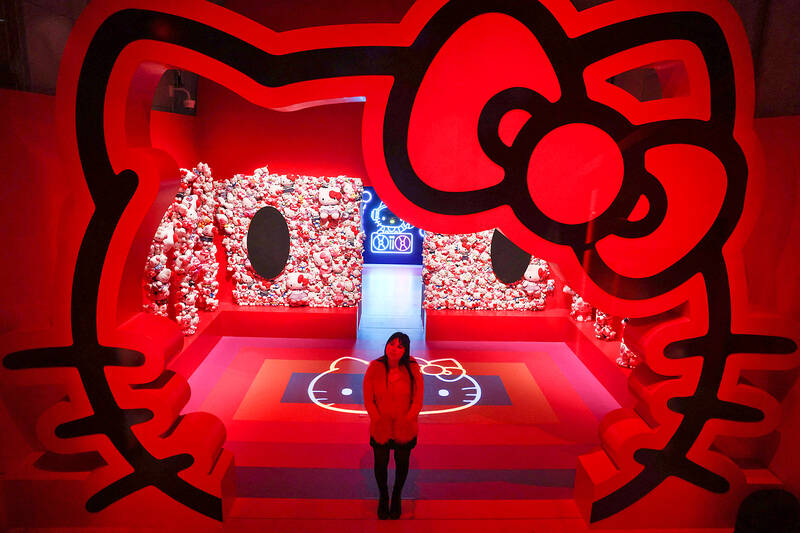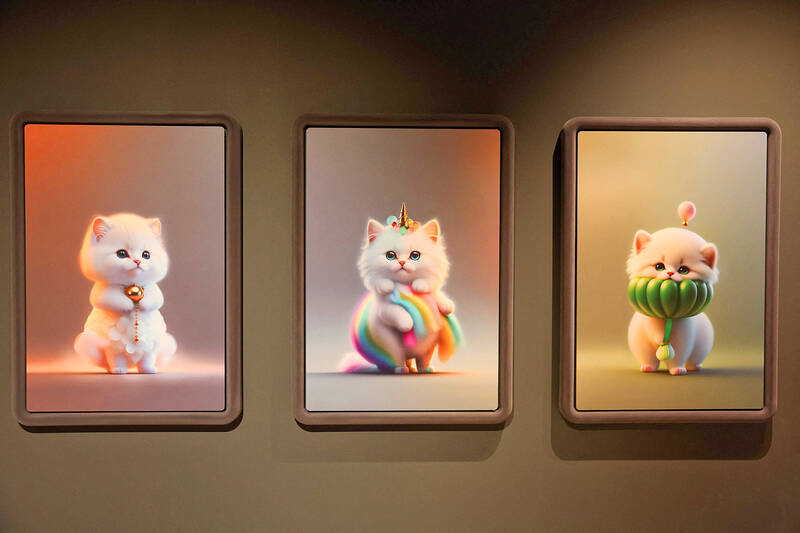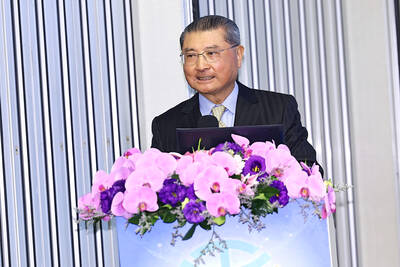From cats and plushies to emojis, a new central London exhibition which opened on Thursday is exploring the “irresistible force” of “cuteness.”
Even before the doors to “CUTE” opened at Somerset House, influencers in Japanese schoolgirl uniforms, Hello Kitty dresses and Pikachu hats playfully posed for photos to charm their social media followers.
The exhibition blends art with an array of musical clips, video games and memes from social media, exploring a largely virtual culture that has swept across the globe with the explosion of the Internet.

Photo: AFP
One room of CUTE is a tribute to cats, which make up some of the most viewed content on the Internet, contrasting 19th-century black-and-white feline photographs with futuristic artificial intelligence-generated rainbow kitten portraits.
Further on, a collage of curly-haired Renaissance cherubs — the original cute babies of art history — intermingles with plush toys, mangas and iconic figures from the kawaii (cute, 可愛) culture that emerged in 20th-century Japan.
For the exhibition’s curator, Claire Catterall, the concept of cute is so vast that she struggles to define it.

Photo: AFP
“The exhibition unpacks what cuteness is, so it’s a very slippery scene,” she said. “It’s very hard to define. It’s very tricky. And in many ways, that’s the power of it. It’s so many different things all at once.”
In sections divided by cat-shaped or rainbow arches, contemporary works share space with commercial products such as Tamagotchi toys or Sylvanian Family figures, reminding visitors that cuteness is a lucrative billion-dollar business.
The CUTE exhibition is sponsored by Japanese company Sanrio Co, which globally markets merchandise of the feline-inspired character Hello Kitty, created about 50 years ago.
Visitors meander under an archway adorned with the character’s likeness, walls blanketed in colorful plush toys, before shimmying under the Hello Kitty disco’s glitter ball.
“Cuteness and capitalism are so closely intertwined,” Catterall said. “There is this kind of quite queasy quality about that which makes people feel really uncomfortable.”
Although cuteness lives “within the capitalist structures which spawned it,” it could also be what disrupts it the most, she added.
The aesthetics of cuteness were once mocked or adopted ironically but its values and dress codes are now championed by many young people as they allow for an “existence outside the norms,” particularly for women and the queer community, Catterall said.
“I think for a long time, cuteness has been considered childish and inconsequential and not serious, but this exhibition will hopefully show that there’s so much more to it than that,” the curator said. “It’s actually really something to be taken seriously, and can tell us so many things about us and the world around it.”
CUTE also touches on a more political dimension of cuteness, in a section featuring a fuchsia pink balaclava from the Russian feminist punk band Pussy Riot, known for their provocative protests against Russian President Vladimir Putin.
As immersive exhibitions and museums proliferate worldwide, CUTE, open to the public until April 4, also emphasizes interactivity.
Visitors can enjoy vintage Japanese video games in an arcade room or relax at a “pyjama party” in a vast teen bedroom complete with bean bags and pop music, created by British artist Hannah Diamond.
“It’s exuberant, it’s exhilarating, it’s empowering,” Catterall said. “We wanted to create a space where people could come in, dance, feel really happy, cover themselves in Hello-Kitty-glow of goodness.”
Cuteness is not just an “aesthetic,” she said. “It’s a feeling.”

When an apartment comes up for rent in Germany’s big cities, hundreds of prospective tenants often queue down the street to view it, but the acute shortage of affordable housing is getting scant attention ahead of today’s snap general election. “Housing is one of the main problems for people, but nobody talks about it, nobody takes it seriously,” said Andreas Ibel, president of Build Europe, an association representing housing developers. Migration and the sluggish economy top the list of voters’ concerns, but analysts say housing policy fails to break through as returns on investment take time to register, making the

‘SILVER LINING’: Although the news caused TSMC to fall on the local market, an analyst said that as tariffs are not set to go into effect until April, there is still time for negotiations US President Donald Trump on Tuesday said that he would likely impose tariffs on semiconductor, automobile and pharmaceutical imports of about 25 percent, with an announcement coming as soon as April 2 in a move that would represent a dramatic widening of the US leader’s trade war. “I probably will tell you that on April 2, but it’ll be in the neighborhood of 25 percent,” Trump told reporters at his Mar-a-Lago club when asked about his plan for auto tariffs. Asked about similar levies on pharmaceutical drugs and semiconductors, the president said that “it’ll be 25 percent and higher, and it’ll

CHIP BOOM: Revenue for the semiconductor industry is set to reach US$1 trillion by 2032, opening up opportunities for the chip pacakging and testing company, it said ASE Technology Holding Co (日月光投控), the world’s largest provider of outsourced semiconductor assembly and test (OSAT) services, yesterday launched a new advanced manufacturing facility in Penang, Malaysia, aiming to meet growing demand for emerging technologies such as generative artificial intelligence (AI) applications. The US$300 million facility is a critical step in expanding ASE’s global footprint, offering an alternative for customers from the US, Europe, Japan, South Korea and China to assemble and test chips outside of Taiwan amid efforts to diversify supply chains. The plant, the company’s fifth in Malaysia, is part of a strategic expansion plan that would more than triple

Taiwanese artificial intelligence (AI) server makers are expected to make major investments in Texas in May after US President Donald Trump’s first 100 days in office and amid his rising tariff threats, Taiwan Electrical and Electronic Manufacturers’ Association (TEEMA, 台灣電子電機公會) chairman Richard Lee (李詩欽) said yesterday. The association led a delegation of seven AI server manufacturers to Washington, as well as the US states of California, Texas and New Mexico, to discuss land and tax issues, as Taiwanese firms speed up their production plans in the US with many of them seeing Texas as their top option for investment, Lee said. The